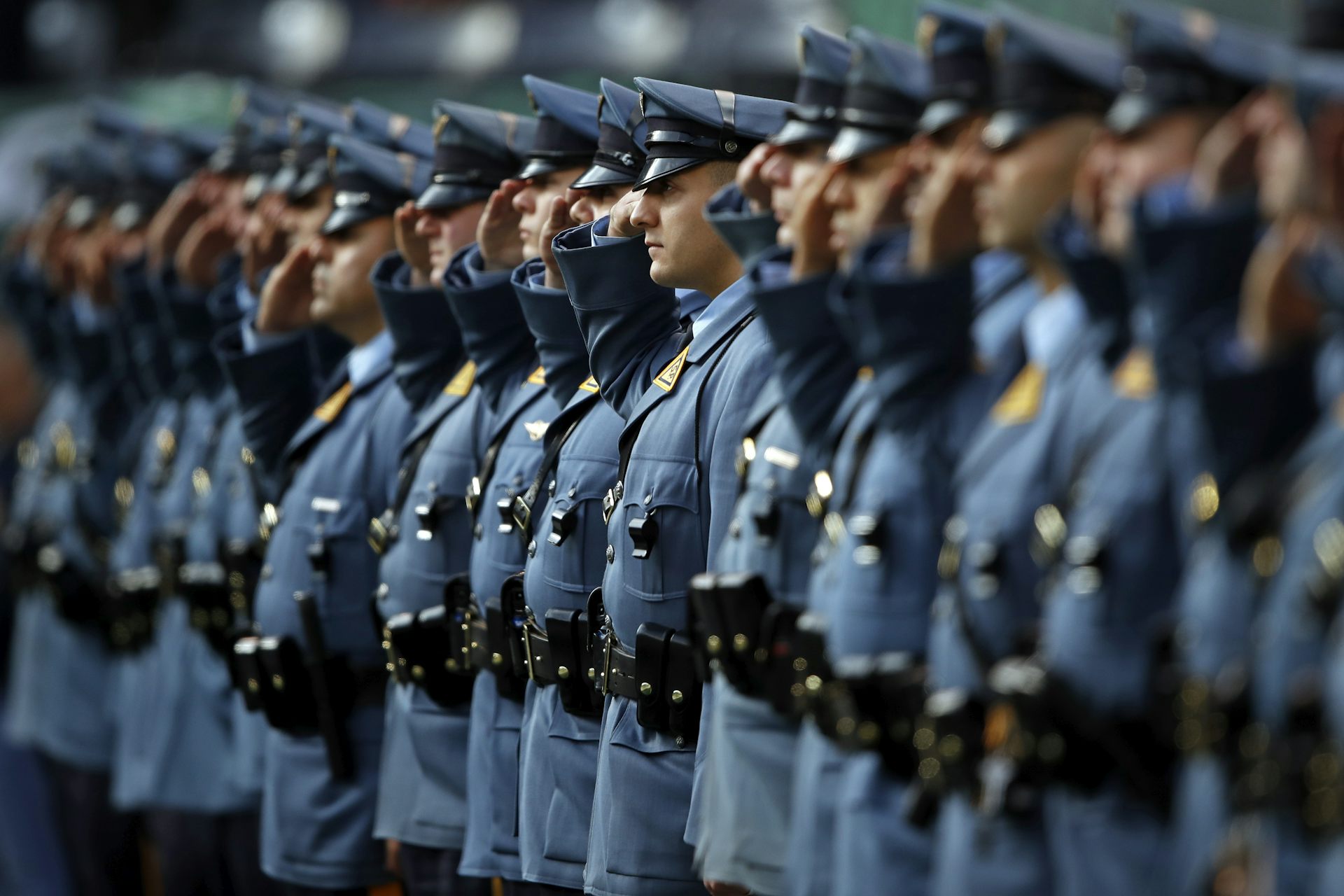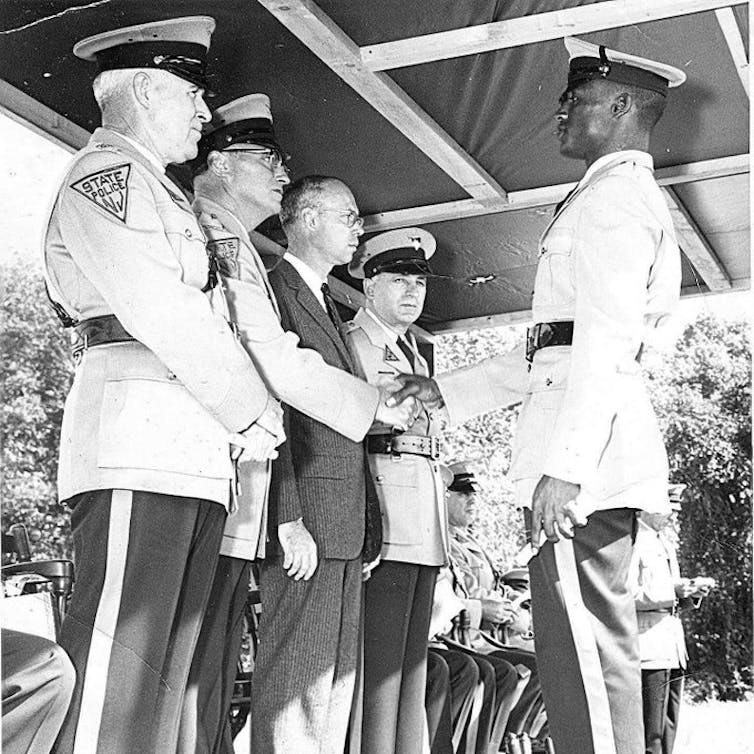
The New Jersey State Police, founded 100 years ago, was created to counter the influence of the state’s rising populations of African Americans and immigrants, whom white residents feared.
My research into the agency’s culture found that the agency emerged as the result of a seven-year campaign by the state’s Chamber of Commerce to replace rural police and county sheriffs with a statewide professional force.
A key element of the chamber’s effort was a 225-page report, issued in 1917, written by Paul Garrett, a well-known businessman, whose reputation helped boost the idea for a state police agency.
Garrett’s writing focused on what he called the “foreign problem” in 13 of the state’s 21 counties, which was how he described crimes allegedly committed by African American and foreign-born residents in these communities. The report contained stark racial and ethnic epithets and stereotypes, including claims that “negroes come from the South to this place for the summer and give much annoyance,” and “foreigners should be given full freedom so long as they are law abiding. But the many instances of rape and robbery and assault and battery due to them would indicate that the problem has not yet been adequately solved.”
Garrett also praised the nation’s first modern state police force, in Pennsylvania, for its “military and physical prowess” at controlling the nonwhite population, including their ability to “shoot down a n—r a mile off.”
Military origins
When the New Jersey legislature created the state police in 1921, it did not replace other law enforcement agencies, but was clearly intended to be a model for other New Jersey police departments. From the beginning, the agency’s superintendent, a career military officer named H. Norman Schwarzkopf Sr., took pains to promote the new agency to the public.
In radio speeches, newspaper interviews and eye-catching photo spreads in magazines, he promised the state police would have “a steady and impartial line of conduct in the discharge of its duty … cleanly, sober and orderly habits and … a respectful bearing to all classes.”
But the police force’s internal publication, The Triangle, told a different story. In a 1924 dispatch called “We Must Have a Little Fun,” an unnamed trooper wrote:
“It has been found out that some of the men stationed at Haddon Heights are carrying shotguns with # 2 Buck, hunting for ‘colored gentlemen.’ Corporal Wilson has asked that we make application for some rubber sling shots.”
Racist tendencies
A year later, The Triangle reported on an encounter in which a Black man had shot at a trooper, injuring the policeman’s hand, before being shot dead himself:
“A call came in that Trooper Simpson had killed a man in a pistol duel. … Corporal Sperling, talking to Sergeant Hoch with all seriousness, said ‘Can you beat that, I wish the men would pick some other day outside of Saturday afternoon to a kill a n—r.’”
The public, however, was told something else. Schwarzkopf honored Trooper Simpson for his heroism, noting in messages published in newspapers across the United States that the trooper worked the rest of his shift despite his injury.
There were other racially controversial incidents, including a trooper in 1937 shooting and nearly killing a Black teenager for joyriding – something not then viewed as a real crime. In the 1950s, documents show, troopers paid particular attention to conducting traffic stops on migrant workers, who were often African Americans or Puerto Ricans.

A toxic work environment
The first African American trooper didn’t join the New Jersey State Police until 1961. That man, Paul Dean McLemore, years later told legislators his white colleagues had hung flyers around the workplace referring to African Americans as “porch monkeys, coons, and saucer lips.”
Another African American trooper, Isiah Cherry, who started in 1967, told the author of a history of the state police about when another trooper brought his son to the police barracks. The son looked at Cherry and said, “Daddy, there goes a n—r.” Rather than calling out the racist slur, the father replied, “Yeah, but he’s a good one.”
In July 1967, police beat up and arrested a Black taxi driver, sparking a race riot in the state’s most populous city, Newark, in a year when race riots spread across the country. A Newark police officer, a city firefighter and 24 citizens were killed in the violence.
The following year, a state commission seeking to prevent future unrest reported that during the Newark riots, state police troopers had singled out African Americans for violence and purposely vandalized businesses with window signs indicating they were owned by African Americans.
In more recent years, McLemore has recalled how excited the white troopers were to go to Newark, in one interview recounting that “The guys with me were just ecstatic, like they were going off to war.” He has described how witnessing “the atrocities bestowed on our people” – meaning Black Americans – by the state police, made him realize that he “was on the wrong team.”
Yet, when McLemore spoke out about racism immediately in the wake of the riots, the state police demoted him from detective to clerical worker, and relegated him to an overnight shift filing paperwork. In 1976, he resigned and – after graduating from college and law school – became a civil rights attorney and a judge.
As McLemore was leaving the force, the state entered into a federal consent decree alleging the agency had engaged in racially discriminatory hiring practices. Federal supervision of state police hiring in New Jersey lasted 17 years, until 1992.
Countering racism
In 1989, the Middlesex County Public Defender’s Office identified “a high percentage of black, out-of-state motorists … being stopped on the New Jersey Turnpike by the State Police.” At that time, the New Jersey State Police were involved in Operation Pipeline, a U.S. Drug Enforcement Agency program intended to reduce drug trafficking.
The prosecutor’s scrutiny began a years-long series of investigations and lawsuits alleging various racist practices in New Jersey State Police operations. A state court in 1996 concluded that the state police had a “de facto policy … of targeting blacks for investigation and arrest, violating people’s constitutional rights.
In 1998, two troopers shot at a van carrying three Black men and a Hispanic man, wounding three. The officers claimed their shooting was justified in self-defense, later pleaded guilty to official misconduct and providing false information about the encounter.
That shooting, along with other incidents and allegations, sparked a federal civil rights investigation. One of the revelations from that inquiry was that internal police documents declared that motorists who appeared to be Black or Hispanic could be considered suspicious if they were staring ”straight ahead while driving,“ or carrying “maps, newspapers and toll tickets,” or had sleeping “passengers in the back seat” – or even if they engaged troopers in “friendly dialogue” during traffic stops.
In 1999, the police agreed to another federal consent decree alleging racist policing practices, especially with traffic stops. When the decree was announced, the state’s attorney general publicly acknowledged that racial profiling “is real – not imagined.” Originally intended to last five years, the order stayed in effect until 2009.
But eight years later, in 2017, the state police made President Donald Trump – who espoused white supremacist views and beliefs and encouraged police to treat citizens violently – an honorary trooper, complete with an actual badge number, 45. A badge number is normally restricted only to officers who have completed the state’s police academy – and was not given to any other presidents or politicians.
And in June 2020, amid national outcry about racist police violence, a white trooper shot and killed an unarmed Black motorist. The trooper’s actions are still under investigation.
W. Carsten Andresen, Associate Professor of Criminal Justice, St. Edward’s University
This article is republished from The Conversation under a Creative Commons license.


Leave a Reply